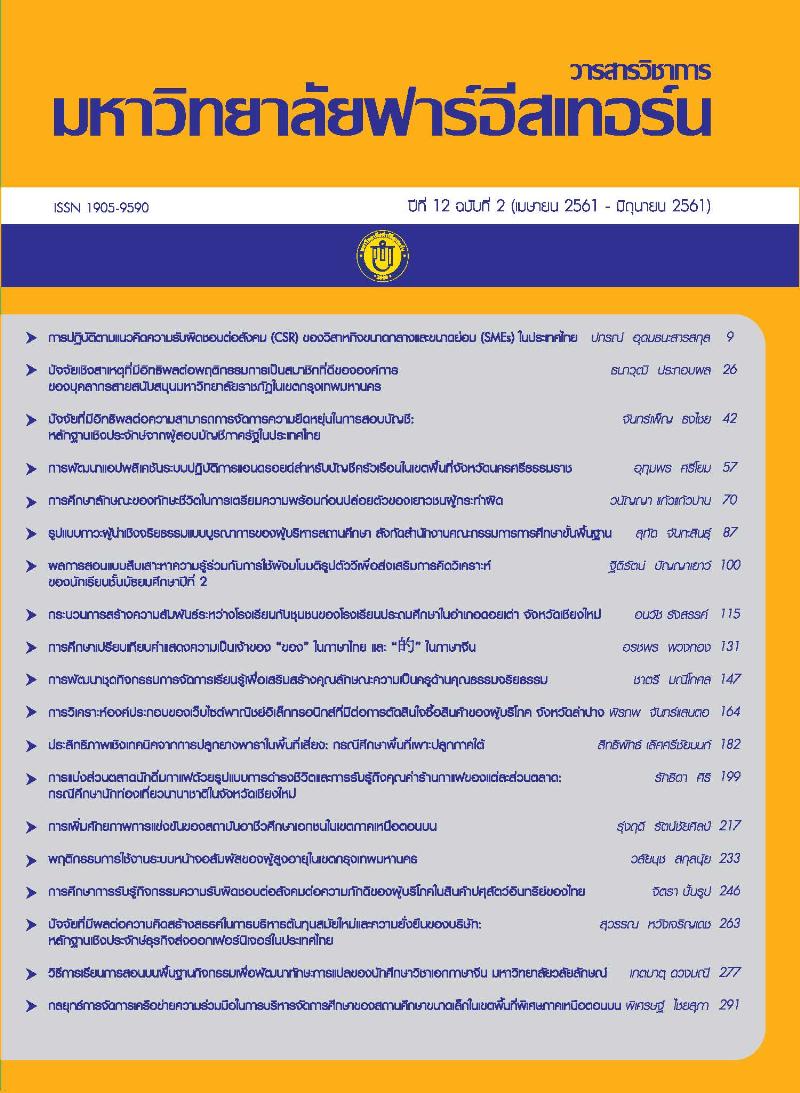Touch Screen Using Behavior of Elderly User in Bangkok
Main Article Content
Abstract
The research objective is 1) to study Bangkok province’s elderly people touch screen devices usage behavior, 2) to study the barriers of using technology, 3) to compare the demand of touch screen devices usage by classifying to gender, age, and educationlevel, and to analyze and 4) the relationship between touch screen devices usage and demographic of elderly people. The sample consisted of 399 Bangkok province’s elderly people. The research instrument included questionnaire. The data were analyzed by using percentage, mean, standard deviation, Chi Square c2, t-test and One-Way ANOVA on the level of statistical significant .05.
The results of the study revealed that 1) the most respondents were women aged 60-64 years old with lower undergraduate education and the income level is lower than 20,000 baht, 2) the barriers of touch screen devices using were text and iconswere too small,3) The different comparison of demand for touch screen devices using by classifying to gender and education level found that the overall demand was no different, by classifying to age found that various age groups had the demand for Tablet PC using was different and 4) the relationship between touch screen devices usage and demographic of elderly peoplein playing games was puzzle games. In the communication found that Facebook, Line, E-mail depended on age. In the works found that document, E-mail, and Facebook depended on education level.
Article Details
1. Any views and comments in the Journal of Social Innovation and Lifelong Learning are the authors’ views. The editorial staff have not to agree with those views and it is not considered as the editorial’s responsibility.
2. The responsibility of content and draft check of each article belongs to each author. In case, there is any lawsuit about copyright infringement. It is considered as the authors’ sole responsibility.
3. The article copyright belonging to the authors and The Far Eastern University are copyrighted legally. Republication must be received direct permission from the authors and The Far Eastern University in written form.
References
2. ข่าวฐานเศรษฐกิจ. (2559). จ้างผู้สูงอายุ 60 ปี ทำงานทันเห็นปีนี้. [ออนไลน์]. [1 ตุลาคม 2559] แหล่งที่มา: https://www.thansettakij.com/content/72744
3. เฉลิมพล แจ่มจันทร์. (2555). ข้อพิจารณามโนทัศน์ใหม่ของ “นิยามผู้สูงอายุ” และ “อายุเกษียณ” ในประเทศไทย. วารสารประชากร สมาคมนักประชาการไทย. ปีที่ 4 ฉบับที่ 1 (กันยายน 2555-กุมภาพันธ์ 2556).
4. ชัยฤทธิ์ โพธิสุวรรณ และอรุณี บุญอุรพีภิญโญ. (2542). ความพึงพอใจในชีวิตของผู้สูงอายุ : กรณีศึกษาชมรมผู้สูงอายุ ศูนย์บริการสาธารณสุข ภาค 2 กรุงเทพมหานคร. วารสารศึกษาศาสตร์ปริทัศน์. ปีที่ 14 ฉบับที่ 3.
5. ธัญญา แสงสีแก้ว และคณะ. (2552). ปัจจัยที่มีผลต่อพฤติกรรมส่งเสริมสุขภาพของผู้สูงอายุในเขตความรับผิดชอบของศูนย์สุขภาพชุมชนร่วมใจ โรงพยาบาลวังทอง. รายงานการวิจัย. มหาวิทยาลัยนเรศวร.
6. ธนรัตน์ แต้วัฒนา. (2556). การพัฒนาระบบช่วยเหลือผู้ประเมินคุณภาพในระดับอุดมศึกษาสำหรับคอมพิวเตอร์พกพาแบบหน้าจอสัมผัส. รายงานการวิจัย. มหาวิทยาลัยเทคโนโลยีพระจอมเกล้าพระนครเหนือ.
7. ณัฐกานต์ บุญรอด และ ทิพยา จินตโกวิท. (2552). แนวทางในการออกแบบการสร้างเนื้อหาบนเว็บไซต์สำหรับผู้สูงอายุ. รายงานการวิจัย. มหาวิทยาลัยเทคโนโลยีพระจอมเกล้าพระนครเหนือ.
8. ผู้จัดการออนไลน์. (2557). “ไอซีที” เชื่อมต่อการสื่อสารระหว่างผู้สูงอายุกับลูกหลาน. [ออนไลน์]. [1 ตุลาคม 2559] แหล่งที่มา: https://www.manager.co.th/iBizChannel/ViewNews. aspx?NewsID=9570000097686
9. เพ็ญนภา พวงทอง. (2556). การพัฒนาสื่อการเรียนการสอนเสริม รายวิชาคณิตศาสตร์ ชั้นมัธยมศึกษาปีที่ 1 บนอุปกรณ์แบบหน้าจอสัมผัส ระบบปฏิบัติการแอนดรอยด์.วิทยานิพนธ์. มหาวิทยาลัยเทคโนโลยีพระจอมเกล้าพระนครเหนือ
10. ศรัณย์ จันทรอมรพร. (2556). การพัฒนาเกมต่อภาพบนหน้าจอสัมผัสแบบหลายจุดสำหรับผู้สูงอายุ. รายงานการวิจัย. มหาวิทยาลัยเทคโนโลยีพระจอมเกล้าธนบุรี.
11. ศุภชัย ปิติกุลตัง. (2556). สถานการณ์และแนวโน้มของครอบครัวไทย. เอกสารประกอบการประชุมวิชาการอนามัยครอบครัวแห่งชาติ ครั้งที่ 6. หน้า 1-8.
12. สำนักงานคณะกรรมการพัฒนาการเศรษฐกิจและสังคมแห่งชาติ. (2559). ประชากรสูงอายุ ปี พ.ศ. 2533 – 2583 รายปี. [ออนไลน์]. [30 ตุลาคม 2559] แหล่งที่มา:
https://social.nesdb.go.th/SocialStat/StatReport_Final.aspx?reportid=1209&template=2R1C&yeartype=M&subcatid=27
13. สำนักสถิติเศรษฐกิจและสังคม. (2556). สรุปผลที่สำคัญ สำรวจการมีการใช้เทคโนโลยีสารสนเทศและการสื่อสารในครัวเรือน พ.ศ.2556. สำนักงานสถิติแห่งชาติ.
14. Arfaa, J. and Wang, Y.K. (2014). An Accessibility Evaluation of Social Media Web- sites for Elder Adults. Switzerland: Springer International Publishing, 13-24.
15. Beer, J. M., & Takayama, L. (2011, March). Mobile remote presence systems for older adults: acceptance, benefits, and concerns. In Proceedings of the 6th international conference on Human-robot interaction (pp. 19-26). ACM.
16. Bright, A. K., & Coventry, L. (2013). Assistive technology for older adults: psychological and socio-emotional design requirements. In Proceedings of the 6th International Conference on Pervasive Technologies Related to Assistive Environments (p. 9). ACM.
17. Evans, B. (2013). Slides: Mobile is eating the world. Retrieved from https://qz.com/ 145704/slides-mobile-is-eating-the-world/
18. Fan, C., Forlizzi, J., & Dey, A. (2012, October). Considerations for technology that support physical activity by older adults. In Proceedings of the 14th international ACM SIGACCESS conference on Computers and accessibility. (pp. 33-40). ACM.
19. Mirum Thailand Team. (2015). Digital Life Survey. Mirum Thailand Co., Ltd.
20. Nicolau, H., & Jorge, J. (2012, October). Elderly text-entry performance on touchscreens. In Proceedings of the 14th international ACM SIGACCESS conference on Computers and accessibility (pp. 127-134). ACM.
21. Van De Watering, M. (2005).The impact of computer technology on the elderly. Retrieved June, 29(2008), 12.

